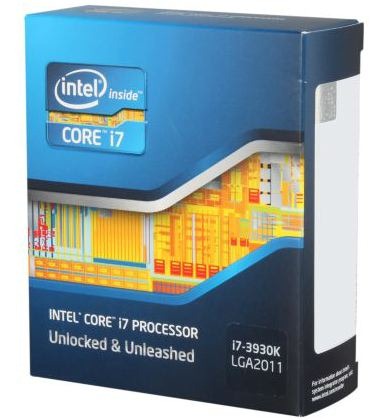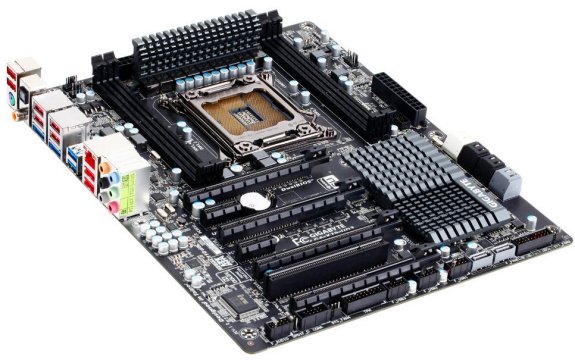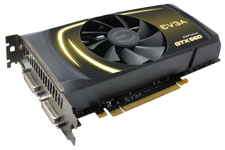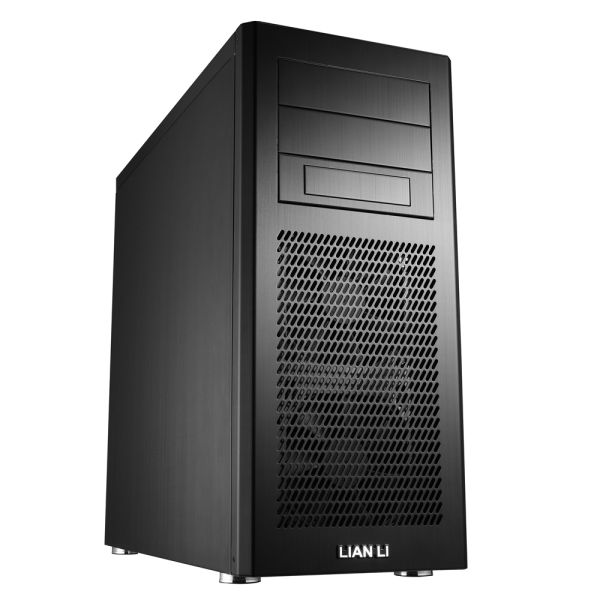Holiday 2011 Mainstream High-End Buyer's Guide
by Zach Throckmorton on December 9, 2011 12:00 AM EST- Posted in
- Guides
- AMD
- Intel
- Sandy Bridge
- CrossFire
- Sandy Bridge E
- Holiday 2011
- NVIDIA
Productivity powerhouse

Intel's Sandy Bridge-E CPU architecture recently launched in the form of two SKUs: the $1000 Core i7-3960X and the $600 Core i7-3930K. These chips differ ever so slightly in that the 3960X has 15MB L3 cache compared to the 3930K's 12MB L3 cache, and the 3960X's stock and Turbo clockspeeds are 100MHz higher than the 3930K's. That is, $400 clearly represents very diminishing returns. Anand reviewed the 3960X recently and found that compared to the Core i7-2600K, the 3960X won in single-threaded performance by a very narrow margin. By extrapolation, the 3930K recommended for this productivity PC will perform very similarly to the 2600K in single-threaded applications. However, because of the SNB-E chips' extra two cores compared to the 2600K, their multi-threaded performance advantage is, as Anand put it, "staggering."
You can see how the 3960X fares against the 2600K on Bench—and recognize that the 3930K we're recommending here will perform ever so slightly slower than the 3960X (unless you choose to overclock). It is critical to understand the nature of your workflow—are you using heavily multi-threaded applications or not? If you are, will your workflow performance improve enough using a 3930K over a 2600K to justify the extra $300 or so cost? If the answer to both of these questions is "yes", then this computer is designed for you. Because neither SNB-E CPU comes with a cooler, we're once again going with Corsair's H80 water-cooling kit.

Intel's SNB-E CPUs use a new socket, LGA 2011. Gigabyte's GA-X79-UD3 is an ATX form factor motherboard that represents a good value amongst X79 chipset boards. If your applications benefit from GPU acceleration, it has two PCIe x16 and two PCIe x8 lanes, though of course filling those lanes will push the cost of the build from just over $2000 to much higher depending on what GPUs you buy.
SNB-E supports quad channel memory, and the GA-X79-UD3 has four DIMM slots. The board's max memory support is 32GB, though we're going with 16GB total here for cost reasons. Again, springing for four 8GB modules might or might not be worth the additional investment; you'll have to make that decision based on your particular needs.
One of the drawbacks with SNB-E compared to SNB is that there's no integrated graphics at all, so you need to buy some form of GPU even if you don't plan on playing any games. Then again, for professional video work you'd almost certainly want a decent GPU regardless. Given we're looking at the high-end of the market and recommending a $1000  platform, we're going to give our primary recommendation to NVIDIA's GTX 560, which has slightly less CUDA cores and lower clocks than the GTX 560 Ti but still represents a fairly healthy upgrade from the GTX 550 Ti. We're going with NVIDIA here as we've had reasonably good experiences using their GPUs in Adobe Premiere, though you can just as easily go with an AMD Radeon HD 6850--and the two GPUs would trade blows in gaming benchmarks.
platform, we're going to give our primary recommendation to NVIDIA's GTX 560, which has slightly less CUDA cores and lower clocks than the GTX 560 Ti but still represents a fairly healthy upgrade from the GTX 550 Ti. We're going with NVIDIA here as we've had reasonably good experiences using their GPUs in Adobe Premiere, though you can just as easily go with an AMD Radeon HD 6850--and the two GPUs would trade blows in gaming benchmarks.
If you feel the GTX 560 is overkill for what you plan on doing, our alternate recommendation is AMD's Radeon HD 6670, which costs about half as much but only has one third the performance potential. Our NVIDIA alternative at the low end would be the GT 440 GDDR5, which costs a bit more than the HD 6670 but should also have a bit better performance. On the other hand, if you're really doing professional work, you'd probably want a workstation level OpenGL card. Never mind that most workstation users buy prebuilt systems--we've covered that market already. For a DIY workstation, you could easily double the cost of what we're putting together by adding a high-end Professional card. In that case, you probably know better than us whether you'd like a Quadro 5000/6000 or a FirePro V8800/V9800, so we'll leave the choice to you.
Because a $2000 PC without an SSD is a travesty, we're recommending Crucial's M4 128GB again, a reliable, relatively speedy SSD with lots of space for your OS and productivity applications with large installation sizes. Many workflows (such as intensive Photoshop usage) benefit from a fast scratch disk, so we're also including a Samsung F3 1TB. Finally, to round out the storage, we have a capacious 3TB Hitachi Deskstar for mass storage. At the risk of sounding repetitive, be  sure you understand your workflow before dropping hundreds of dollars on storage configurations you might not really need. As noted in the HTPC build, you might also want to hold off on the third storage drive until HDD prices drop.
sure you understand your workflow before dropping hundreds of dollars on storage configurations you might not really need. As noted in the HTPC build, you might also want to hold off on the third storage drive until HDD prices drop.
Though this PC is extremely powerful, it is not especially power-hungry. A productivity computer should be, above all else, reliable, and for this reason SeaSonic's SS-560KM power supply gets our recommendation. This is a highly efficient PSU and in my experience, it's very quiet and supplies components with very clean power. Work PCs are often conservative in their looks, but Lian-Li's PC9F looks very sharp while looking modest. It's also a great case in terms of its thermals and acoustics.
| Component | Product | Price |
| CPU | Intel Core i7-3930K | $600 |
| CPU cooler | Corsair H80 | $94 |
| Motherboard | Gigabyte GA-X79-UD3 ATX | $270 |
| RAM | (2) Crucial 8GB (2x4GB) DDR3 1333 | $80 (total) |
| GPU | EVGA GeForce GTX 560 | $180 ($15 MIR) |
| GPU (Alternate) | Sapphire Radeon HD 6670 | $80 ($15 MIR) |
| SSD | Crucial M4 128GB | $210 |
| HDD | Samsung Spinpoint F3 1TB | $150 |
| HDD | Hitachi Deskstar 3TB | $260 |
| PSU | SeaSonic SS-560KM 560W | $135 |
| Case | Lian-Li PC9F | $120 |
| Optical drive | ASUS DRW-24B1ST/BLK/B/AS | $19 |
| Operating system | Microsoft Windows 7 Professional | $130 |
| Total: | $2248 | |
We have a few concluding remarks on the next page.










52 Comments
View All Comments
Z Throckmorton - Friday, December 9, 2011 - link
Hi Araemo - Anand performed a great analysis of RST a few months ago (http://www.anandtech.com/show/4329/intel-z68-chips... You can see that RST definitely does not suck compared to just going with a dedicated OS/app SSD. That said, it's also clear that RST's utility really depends on usage patterns. From the sound of it, it sounds like you'd really benefit from a 64GB caching SSD. I personally have not used RST for an extended period of time; I've just moved from a 40GB to 80GB to 120GB SSD as funds have permitted. I tinkered with it and found the time and effort was simply not worth it compared to the cost of a dedicated OS/app SSD. ...Watch for sales (Intel's 320 120GB came close to $100AR on Black Friday a few weeks ago), or grab a used one off of our FS/T forums! :)Araemo - Friday, December 9, 2011 - link
I did read that, but I forgot about the after-usage tests.. though unless I'm misreading it, he doesn't go into how long before you get back to the good speeds, is it after one more launch, or does it take a few to re-evict the other apps?DanNeely - Friday, December 9, 2011 - link
I bought a 120 about 2 years ago, and am waiting for a 240gb model to drop below $300. I haven't seen anything except sandforce get that low, and after all the firmware problems they've had I'm hesitant to buy one even though the BSOD bug has supposedly been fixed.FormulaRedline - Friday, December 9, 2011 - link
Unless you plan to attach your ~$2,000 gaming machine to a $90 monitor, I think the gaming system with a single 580GTX is going to be severly limited by the graphics card. If I was doing a $2k build today, specifically for gaming, I'd find a way to squeeze 580 SLI in there. By no means do I think it unreasonable to spend half the money of a gaming build on the GPUs. Certainly you should be allocating more than a quarter.Drop that SSD down to 64GB (basically the OS and some common programs), cut back the HDD storage (add more when prices drop), get a smaller PSU (I run 480GTX SLI, more power hungry cards, with my Kill-A-Watt showing draw during gaming of <550W...so I question the bench results), swap the water cooler for a good $30-$40 air cooler (you'll still be GPU bound for gaming), and use the freed up cash on more GPU. SLI drivers are so good these days that even a 570 SLI setup would be a huge step up from a single 580. That is computer that will run the newest games on the highest setting at big resolutions (2560x1600@60Hz) or even 3D (1920x1080@120Hz).
JarredWalton - Friday, December 9, 2011 - link
I'm running a 30" LCD off a single GTX 580, and even the latest games are generally playable at max details and 2560x1600. Batman: Arkham City runs fine with DX11 + AA + PhysX (post-patch), Skyrim gets 8xAA and DX11, Rage could do max details and then some, Battlefield 3 is at least 40+ FPS... I hope you get the point. My biggest gripe with a single GTX 580 is actually something SLI GTX 580 won't really fix: 1.5GB VRAM. At maximum detail, we're now starting to see games push beyond that mark, even at 1920x1200/1080p, so some time in the next year or so I expect 1.5GB to prove insufficient.FormulaRedline - Friday, December 9, 2011 - link
Maybe so (unfortunately we're still in the area of console ports for systems that came out in 2005). However, consider a modded Skyrim running high resolution textures with AF x16 and AO enabled in the Nvidia control panel. Or, as you point out, some stock games like BF3. These will bring the article's machine below VSYNC, while the added GPU power would add framrate back.In other words, there is something to gain, even if only in some games (though I would also argue those games are the most relevant), while the cuts to get there do not sacrifice anything. Yes, watercooling to get a few more MHz out of the CPU or a bigger SSD to load the whole CS5 suite onto would be great for a productivity machine, but that's not the purpose of this build.
As to the 1.5GB...I'm with you there. Personally, I wouldn't be building a machine right now; I'd be waiting for the next generation of cards at this point. Of course always waiting for the next best thing is a losing game, but I think we're out of the sweet spot for top end GPUs now.
l_d_allan - Friday, December 9, 2011 - link
ggathagan - Friday, December 9, 2011 - link
Not a particularly intelligent comment, given the plethora of CPU, GPU, PSU, motherboard, memory cooling and case reviews on this site that supply the very metrics you crave.This isn't a review, it's a buyer's guide
coffeejunkee - Friday, December 9, 2011 - link
These systems look fairly decent but I think you'll need a 3-pin y-splitter for the workstation to connect both the PC-9F front fans.The R3 can fit up to 7 fans, in that case you'll probably want a separate fancontroller since the GA-Z68XP-UD3 has only 1 controllable casefanheader.
Not convinced about H80 though, doesn't seem worth the money to me when you can get Thermalright Macho for less than half the price. 'Introduction to real watercooling' sounds like a non-argument to me.
ven - Friday, December 9, 2011 - link
In the gaming ring everything else is fine, but as for the case i think CM HAF 912 will be more suitable than R3. Fully vented front panel than compared to small sideways front intake in R3, so more air flow and also if you remove the HDD cage(CM) Graphics card will get direct cooling from one of the front panel fan it is also much cheaper than R3($59)As for the motherboard, Asus Maximus-iv Gene-Z is also nice option both the Gigabyte and Asus are almost same in the spec, Asus has some more whistles like ROG connect,Better UEFI, and also it looks cool.